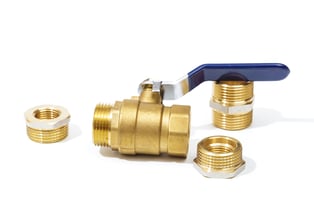Our ARMI | MBH team is continuing their work to develop more new products to ensure that we can provide the products you need for your analytical testing. We are proud to announce the release of 6 new CRMs including one leaded brass, and 5 lead alloys. If you want to learn more about any one of products listed you can simply click on the links to view the certificate of analysis.

While brass is well known both for high strength and corrosion resistance, lead is known for excellent corrosion resistance and ductility. So, with the addition of lead to brass it increases the machinability, strength and corrosion resistance of the brass. Leaded brass can contain up to 3.5%. Medium Lead brass is often used for various fasteners and small fittings, and allows for between 1.5-2.5% Pb. Our leaded brass, MBH-31X 7835.2 L, falls in the middle of this range with Pb=2.07%, Zn=33.4%, and Cu=63.7%. It is also certified for an additional 13 elements, including Ag, Al, As, B, Bi, Cd, Co, Fe, Ni, P, Sb, Si and Sn.
Lead has a variety of uses, dependent upon its purity and/or the elements that it is alloyed with. Antimony (Sb) is often added to improve hardness and strength, and Pb with 6% Sb specifically has a variety of uses, from sheets intended for use in the chemical industry, to piping used in plumbing and water distribution. We are releasing 2 Pb/Sb standards, MBH-85X ANTH G has Sb=6.07%, Sn=1.35%, As=0.185% and is also certified for an additional 10 elements, including Ag, Bi, Cd, Co, Cu, Ni, S, Se, Te and Zn. The second Pb/Sb standard is MBH-85X PSB10 C, With Sb=10%, Sn=0.134% and Cu=0.147%. This CRM is also contains certified values for Ag, As, Bi, Cd, Ni, Se and Zn.
There are several levels of “pure” lead, from Pure/Corroding lead (Pb>/=99.94%) to chemical lead (Pb >=99.90%). Pure lead is the most common type produced in the US. It is also called corrosion lead, due to an old manufacturing process used to make it, not for its chemical properties. The differences in these two purity levels is often in the Bi content. Our new standards MBH-83X PR4 J and MBH-83X PR12 B are both pure leads, with Bi<0.013%, and total certified elements <0.06%.
Lastly, we are introducing a Lead/Tin alloy to our portfolio. The purpose of adding tin to Pb alloys can increase hardness and strength, but more importantly, it allows for improved melting, casting and wetting abilities, and the automotive industry uses lead alloys with a wide array of tin levels below 30%. Our new Pb/Sn alloy, MBH-85X PSN2 D has Sn=1.9%, and is certified for 10 additional trace elements, including Ag, As, Bi, Cd, Cu, Fe, Ni, Sb, Se and Zn.




